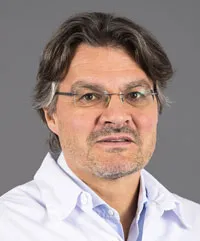Functional neurosurgery focuses on adjusting the functions of neural networks involved in movement, spasticity, pain or behavior. By modulating certain groups of neurons, the surgeon can increase or decrease neural activity for therapeutic purposes.
Stereotaxy
This is a technique used in neurosurgery to precisely reach hard-to-reach areas of the brain. It allows deep brain biopsies, high-precision focal radiotherapy, or the implantation of deep brain electrodes to be performed.
Deep cerebral stimulation
This approach was first used for movement disorders such as in Parkinson's disease. More recently, it has proven effective in specific cases with psychiatric disorders such as Tourette's syndrome, obsessive-compulsive disorder (OCD) and depression. Deep brain stimulation is used at the University Hospitals of Geneva through multidisciplinary collaboration with the Neurology Division.
Surgery for pain
Pain can be surgically relieved if the cause is neurological. This is the case with some diseases such as trigeminal neuralgia if it responds poorly to drug therapy. Several techniques can be used such as ablations or the modulation of specific parts of the nervous system.
Treatment of spasticity
Spasticity is a disorder of the motor system characterized by involuntary contractions of the muscles. It can occur in the context of many cerebral and spinal (spinal canal) pathologies. The placement of an intrathecal Baclofen pump reduces symptoms and promotes neuromuscular function.
Radiosurgery
Radiosurgery is a non-invasive technique. It can treat benign tumors, brain metastases and some arteriovenous deformities without the need for surgery. Using a beam of rays, it irradiates the relevant area of the brain very precisely. Before each radiosurgery, a multidisciplinary discussion takes place to ensure optimal treatment.
